Content [show]
.
Some indoor plant lovers have adapted to growing citrus trees on the windowsill. Lemon is especially popular. Growing lemon at home will not take a lot of energy from the owner.
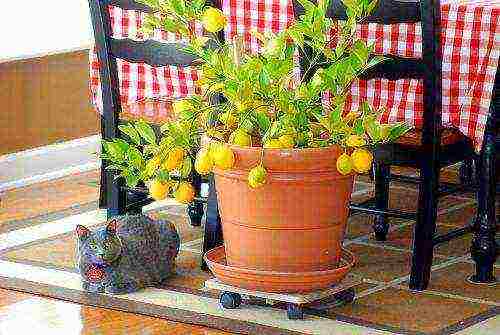
Growing lemon can be done at home
Lemongrass are native to southern countries with warm and humid climates. Therefore, the main task of the grower is to ensure similar microclimatic conditions in the house or apartment.
Why is lemon grown at home?
There are several advantages to breeding lemon crops at home. The main one is the fragrant healthy fruits that the plant produces annually. In addition, placing a lemon on a windowsill can be an interior decoration.
You can grow lemon at home in a pot or tub. The pot is more suitable for dwarf plant varieties, the tub is useful if a large tree is grown from a stone. With a sufficient amount of heat, moisture and light, a room lemon can reach one and a half meters in height and produce up to 150 fruits per season. It is very difficult to achieve such results, but taking into account all the features of care, it can still be done.
Another advantage of growing lemon is the beautiful appearance of the tree. He has a dense and always green crown. During the flowering period, the plant throws out beautiful flowers. They are often covered with mighty green leaves. The only exception is the Ponderosa lemon, whose branches are thin and resemble a spreading bush. Despite the external weakness, the twigs can withstand up to 50 fruits. This decorative tree can be grown on a windowsill, since it does not take up much space.

Lemon bush can produce up to 50 fruits
General features of growing lemon at home
Lemon is a thermophilic tree. Lack of heat affects the fact that the plant grows poorly, gets sick or dies. If you decide to put a pot on the window, then you must:
- Choose south or east side. The plant should receive a lot of sunlight.
- On sunny days, the tree is placed in the shade, and on cloudy days, it is illuminated with fluorescent lamps.
- In the summer, take the plant out to the balcony or loggia. There it receives more oxygen and solar energy. And only by the fall it is brought back to its original place. In winter, you should monitor the temperature indicator, which should not fall below 10 degrees.
Special attention should be paid to the quality of the soil and the pot. The fact is that lemons have an individual nutritional system. They get water not through ordinary hairs on the roots, but through fungi in the soil. The connection of the house plant with the mycelium of the fungi is sensitive to external factors. It can be easily disturbed by a lack of oxygen, improper watering and sudden changes in temperature.
Before growing a lemon tree, you should take care of a suitable soil. Plant lemons in loose soil types that are pH neutral. It is best to plant citrus in ready-made soil purchased from a specialized store. If the indoor lemon is placed in a self-made substrate, it is important to take into account the proportions of humus, turf and sand. The soil with meadow turf, leafy soil, humus and sand is also popular.
Mistakes in care lead to the fact that the lemon tree at home dies from aridity or excess moisture, poor living conditions or pests.

Lemon prefers the sunny side of the room
Planting lemon
For small plants, a clay pot is suitable, for large plants it is better to use a wooden tub, which is considered the best option for placing citrus fruits. Natural material allows oxygen to pass better to the lemon roots. Before placing the planting material in the pot, it should be inspected for damage. The planting process itself is simple:
- The root collar is buried 5 cm deep.
- The container is filled with soil almost to the very top. Better if there is a space of 1-1.5 cm between the edge of the pot and the soil.
- After planting, the seedling is sprayed with water and watered with a solution of potassium permanganate.
The planted tree is left on the windowsill. A young plant needs a lot of light and warmth. On hot days, it is better to create partial shade, which will save you from burns. It is not worth changing the place for the pot, the lemon does not like moving. Occasionally, you can turn the tree with darkened leaves towards the sun for even heat.
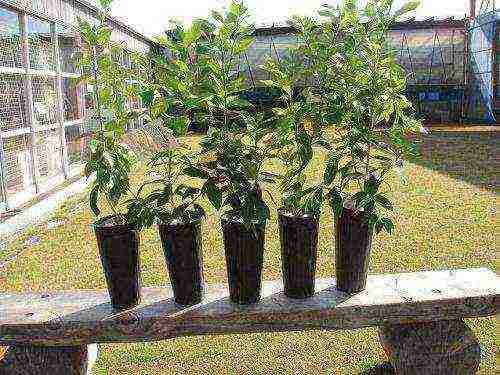
Lemon seedlings are sprayed with water after planting
Growing lemon from seed
If you decide to germinate a varietal lemon from the seed, you should know the peculiarities of its cultivation. This process takes much longer than planting seedlings. To find out how long it takes for the seeds to germinate, you need to take into account the following features:
- The sprout breaks out of the soil 2 weeks after planting. Sometimes it takes more time (up to one month).
- Citrus buds require greenhouse conditions, so the pot with a bone is covered with a cut plastic bottle or wrapped in plastic wrap. Inside such a cap, the humidity is several times higher than in an open space, and the transparency of the bottle allows the ascending sprouts to receive sunlight. In a homemade greenhouse, watering should not be overused. The soil already gives off moisture to the allotted space of the greenhouse, so it should only be sprayed.
- When a small stalk has broken through, it is accustomed to indoor conditions by removing the greenhouse cap for 1-2 hours a day.
- Transplanting into a large pot occurs only when 4 leaves appear on the sprout.
Growing lemon in a greenhouse will also work for mature seedlings. With the correct organization of climatic conditions, you can do without it. It is also not worth rushing with feeding.
Until the citrus root system is fully formed, any external additives will be perceived by the tree as a poison. It is best to do top dressing in the spring or summer, but not earlier than three months from planting.

Growing a lemon from a seed will take quite a long time.
Lemon watering
Growing a lemon at home is not an easy task, often a lemon does not survive for several months. And one of the reasons for this is improper watering. Providing proper home care is essential for the plant to grow healthy and strong. How to properly water
- Provide moderate watering with settled water once a day. You can water it once twice a day (you need to monitor the condition of the soil).
- Water the lemon 2 times a week in winter.
- Drain the accumulated water in the sump immediately after watering. Plant roots can rot from excess moisture.
- Sprinkle lemon leaves daily with warm water.It is especially important to do this in winter, when the air becomes dry from the operation of heating systems.
Experienced growers advise beginners to find a moisture balance: avoid overflow and lack of moisture. With a lack of it, the leaves of any kind of lemon begin to turn yellow. If watering is not done in a timely manner, the microza and the plant die. If yellowed leaves are detected, the lemon should be sprayed with a weak solution of potassium permanganate.
We must not forget about the benefits of a warm shower. Like everything else standing still in the dwelling, the lemon is covered with a layer of dust and dirt. It should be washed off as dust interferes with the process of photosynthesis. Bathing of the plant is carried out no more than 1 time per month.
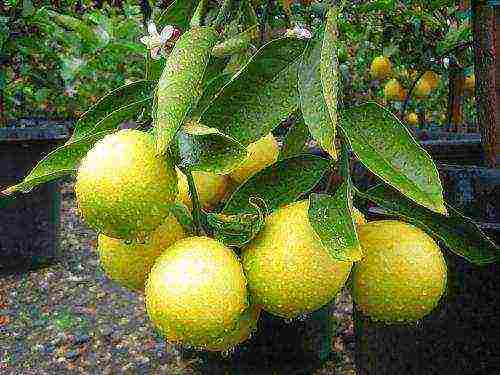
Dust should be regularly washed off lemon leaves.
Lemon fertilization
Recommendations on how to care for a lemon also apply to plant nutrition. Citrus fruits are sensitive to fertilizers. The preparations must be constantly changing, because when using one fertilizer, the pH of the soil can change to an acidic or alkaline side. In such soil, lemon does not ripen, it grows for a long time, gets sick and dies. To avoid this, you should:
- Choose only mineral formulations for fertilization.
- Apply fertilizers from March to October at intervals of 2-3 weeks. For young plants, it is enough to carry out the procedure once a month and a half.
- Combine top dressing with watering in the summer.
- In spring and autumn, feed the plant only after watering. Fertilizer is applied at least 2 hours after the soil is moistened.
- In winter, fertilize once.
Unlike complex mineral fertilizers, not all organic substances are suitable for lemon. The most effective solution is a weak solution of manure with water (1/6) and an extract from wood ash. A special infusion of birch and quinoa leaves is popular.
Some citrus fruit owners are faced with the problem of flowering. When flowers do not appear on the crown among the ripening leaves, this indicates poor feeding. Why does the plant react this way? The fact is that the lemon does not have enough strength to bear fruit. And a change in fertilizer will help him cope with this problem.

From quinoa, you can prepare an infusion for fertilizing lemon
The importance of pruning
The need for pruning is due to decorative and sanitary features. Its shape and scheme most often depend on the purpose of growing the tree. Small ornamental plants do not need sprawling large branches, so they are cut as much as possible, making the crown compact. For citrus fruits that bear fruit, the rule of balancing branches and shoots applies. The most common pruning method is pinching.
It begins after the lemon has reached the age of one year, with preliminary pruning of the main shoot. It is best to leave 30 cm in length. This is necessary so that the lateral buds on the tree begin to sprout.
Only after the lemon gets stronger and gives new branches, they should be pinched. 3-4 leaves remain on each branch. This pruning method allows the tree to grow strong, able to hold and ripen fully.
It is important to prune old dead branches. Lemon spends its powers on them, but it will not work to revive them. Therefore, it is better to rid the lemon of the extra load. Those shoots that grow inside the crown also lend themselves to pruning. They most often prevent neighboring branches from developing and getting enough sunlight.
Lemon harvest
Enjoy the ripe lemon fruit grown on your own balcony or windowsill only if the blooms are formed correctly. Weak immature plants can throw out a large number of flowers in the second year of life. You cannot leave them. The structure of the tree cannot withstand a heavy load, and the lemon will die, giving the fruit all its strength. To grow a large crop, you should:
- In the second year of the lemon's life, leave 2 flowers on the whole tree or completely remove the inflorescences.
- During flowering, carefully monitor the health of the tree, protect it from drafts and carry out all the features of caring for it.
- Know the rule of forming inflorescences - there should be 10 leaves for 1 fruit. All other ovaries are removed.
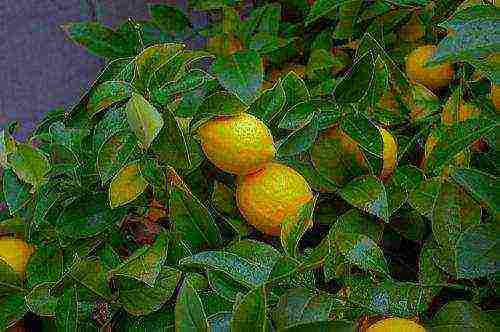
Lemon harvest can be expected 4-5 years after planting.
Do not expect high fertility rates from a houseplant. The tree grows and develops very slowly. Any human error can delay the appearance of blooms. You should constantly monitor the condition of the lemon and feed, cut and water it in a timely manner.
Some citrus fruit owners get their first good fruits within 4-5 years. Their number rarely exceeds 5–8 pieces. A larger harvest will have to wait longer. The tree reaches its maturity only by 8-10 years, and at home the lemon lives up to 40-45 years.
Transplant features
Some citrus owners are faced with the problem of the rapid death of the plant. If its cause depends on watering and fertilization, then the tree suffers from an incorrectly selected pot. Too much capacity causes root rot. It is better to use pots commensurate with the root of the plant and replant the tree only when it becomes cramped. It is best to increase the space gradually, while controlling the growth of the tree's roots.
We must not forget about the proper access of oxygen to the roots. It is better to install the pot on a pallet with a gap so that air can penetrate into the ground. Place a lining of stones or wood under the bottom of the pot.
After transplanting, the citrus is returned to the same place where it stood before. Any change in the environment is bad for the health of the plant. It can hurt and even die. If you want to turn the tree with the darkened side towards the sun, then you should change the angle by no more than 10 degrees. Only in this way will the lemon grow strong and healthy.
Subscribe Be aware of new products on our site
.
Before you start growing lemon at home, you need to pay attention to the fact that the vegetation speed, yield and appearance completely depend on the selected lemon variety. There are many of them: from original to hybrid ones, attracting attention with variegated color and decorativeness.

Potted lemon can be grown at home. However, it will take an effort
In an apartment, lemons grow best on a windowsill, where the sun is bright enough, but there is no scorching sun. They don't like dirty air with a lot of carbon dioxide. Home care for lemon is not difficult, but it requires accuracy.
Lemon conditions
- Sufficient air humidity, regular spraying with standing or structured water.
- Long sunny day, controlled by artificial lighting.
- Regular fractional watering, preferably situational: if the earth did not have time to dry, which happens in winter, then postpone watering until the next day.
- Correctly selected soil. Too light soil with a lot of peat is not suitable, but black soil is heavy for lemon.
- Propagation by cuttings is best done in spring, when the length of the sunny day is increasing.
- The recommendations of experienced gardeners relate to giving the crown to the lemon tree, on the density of which its fruiting and yield depend, as well as breaking off the thorns.
Convenient varieties for home cultivation
In order to grow a lemon tree from seeds at home, you can familiarize yourself with the most unpretentious representatives of this type of plant.
- It will not be difficult to grow a Pavlovsky lemon at home. It is popular for its ripe fruit taste. Its foliage is dark green. The amount of harvest directly depends on it: the thicker, the more harvest will be. On an adult tree from 3 years old, flowers can bloom and fruits ripen at the same time.
- At home, lemon bears fruit for 3-4 years, is one of the most productive, the foliage is less dense, light green.
- "Novogruzinsky" is slightly higher than the rest of Schizandra, it grows up to two meters, the first harvest after 4 years, but it is notable for the fact that there are practically no seeds in it.
- "Lisbon" is one of the most unpretentious, there are a lot of thorns and they need to be removed, the foliage is dense, but if properly grown and looked after, it can bear fruit twice a year.
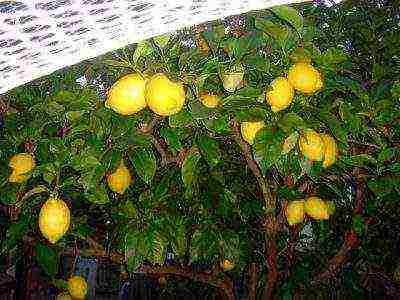
One of the most unpretentious varieties of lemons for home cultivation is "Lisbon"
You should fertilize indoor lemon regularly, but only after the soil has exhausted its nutritional potential.
Suitable primer for lemon tree
- The earth should be of medium density. At the beginning of horticultural practice, it is better to use a ready-made purchased mixture. For lemon at home, a special mixture "For citrus fruits" or "Lemon" is suitable.
- How to mix the soil yourself: 2 parts of turf, 1 part of leafy soil, 1 part of horse manure, 1 part of sand.
- Adjust the amount of the mixture according to the size of the pot.
Required components for self-made soil:
- Turf can be purchased at the store. It consists of redwood grass, tree foliage, small sawdust, part of moss and peat. It is a light soil if there is no clay in its composition. Rich in useful microelements, it is especially important when breeding lemons in greenhouse conditions.
- Leafy land is laborious for preparation, for this it is better to purchase it ready-made. The composition of ripe leaves of fruit trees, linden and maple will provide indoor lemon with thermal insulation of the root system and prevent moisture stagnation.
- Horse or cow dung. The product is easy to buy from online stores. It is rich in nitrogen, phosphorus, potassium and calcium, without which lemon will grow poorly at home and will not bear fruit.
- The sand is used as drainage, and it is also a natural silicon dioxide by its chemical composition, it provides looseness to the earth and prevents it from clumping into lumps through which water cannot seep.

The sand is used as drainage. Loosens the ground and prevents it from falling into lumps
Some experts recommend soaking lemon seeds in a biological growth promoter before planting.
The best example is the root root, it will help the seeds germinate and make growing lemon easier.
First, the seeds must be washed in warm water, put in a ceramic container and completely filled with a biostimulator. Leave in a warm place for an hour or two. Take it out and dry it, after that they need to be planted within the same day. A higher percentage of seed germination is observed in a small greenhouse located on a window.
How to plant lemon seeds
- After the seeds are "awakened", they can be planted in special peat pots, or ordinary plastic ones for seedlings, after placing a layer of drainage on their bottom - pebbles or special expanded clay.
- The layer of earth covering the seed should be no thicker than two centimeters. The soil needs to be moistened, but not to make a "porridge" out of it, for this it will be enough to irrigate from a sprayer. For these purposes, you can prepare a decoction (not strong) of nettle or calendula.
- Lemon buds will develop faster if they create a greenhouse environment on the windowsill. To do this, you need to put on a bag for each individual glass. It should hermetically protect the top layer of the earth from contact with air, you can spray it from the inside with water for a better effect.
Watering is desirable every two days. Observation of condensation on the inner surface of the package will come to the rescue, if it begins to dry out, then you can carry out drip irrigation. Considering which plant variety is chosen, the absence of temperature differences, the type of soil and illumination, it depends on how long it will take until the first shoots appear.
New plants grown in favorable conditions will develop greater resistance to unfavorable factors. This is why most growers prefer the method of home cultivation from seed to growing by cuttings.
Seedling conditions
- Temperature not lower than 18–20 ° C without drafts.
- Watering in small portions, only when needed. It can be alternated with herbal infusions with disinfecting properties.
- Gradually accustom the sprouted seedlings to room temperature.
There are some other guidelines that make it easier to grow lemon in a greenhouse. If the seeds are planted during the cold season and the temperature is low in the area where they are grown, you can use a heat-reflecting film, which is sold in gardening stores. It will better protect not only from the cold, but also in the bright sun, if the seedlings standing on the windowsill were not removed in time.
When lemons appear among the greenhouse seedlings, on which branches are well developed, they can be transplanted into a permanent pot. Its diameter should not exceed 15 cm, otherwise the lemon will grow for a long time. Before growing a lemon tree, it is important to ensure that its location is away from pets.
It is necessary to give it a permanent place on the windowsill and not move it until the tree gets used to the new care, which is different from the greenhouse one. Timely feeding will help to grow lemon at home.
Feeding methods at home
- Horse or cow dung. Top dressing by this method is carried out once every 6 months. It can be carried out additionally at the beginning of flowering or if ripening fruits have appeared on the lemon. Lemon fertilized with biologics grows faster and better resists disease.
- Wood ash mixed with used ground coffee powder, sprinkled with lemon sprouts. The mixture will perform two functions at once: it will drive away insects, if they appear, and it will disinfect the ground. Ash will help prevent old leaves and buds from falling off.
- Aquarium water is an excellent material for stimulating the growth of mature trees. Preference is given to a liquid in which the fish have been kept for no more than a week, otherwise the ground may smell of silt.
- Watering with mixing of bone meal with lemons will be perceived as a biostimulant. In a proportion of no more than 1 teaspoon per glass of water. Water once a month.
It is important to remember that fertilizers obtained from the processing of waste products can both improve the cultivation of lemon at home in a pot, and destroy the plant with their frequent use. It is necessary to observe the measure during breeding and alternate the type of feeding.
After the first ovary has appeared, you need to be patient, because the lemon ripens slowly. A period of illumination helps the fruits ripen, longer than 10 hours a day. To do this, you can use a table lamp, even a 25 W light bulb will do.
A lemon is ripe when its peel has become the characteristic yellow color or the color that the variety suggests, this process will take at least 6-7 months.
Therefore, the recommendation is to plant the seeds, after calculating the period of growing the lemon and caring for it before the onset of winter.
Subscribe Be aware of new products on our site
Lemon is an evergreen citrus tree. The homeland of lemons is the subtropics, so plants love warmth and moisture. In open ground, the tree grows up to 8 meters, although there are also dwarf three-meter trees. Homemade varieties bear fruit all year round with good care.
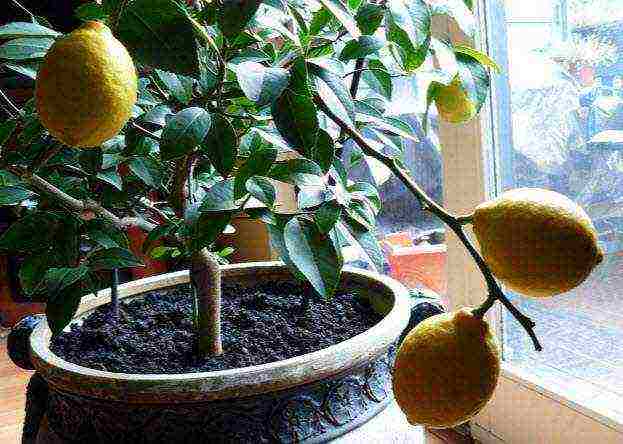
Room lemon - a short description
At home, lemons are grown in flower pots or tubs. Growing a lemon in a tub, you can get from 10-30 fruits every year from a young plant to 200 from an adult. Lemons, which are not inferior in quality to the southern varieties, can be removed from a tree about one and a half meters in height.You can grow a houseplant from a lemon seed, but truly delicious fruits are obtained only from varietal plants. Lemon is a perennial plant and it blooms profusely, although the flowers are not too noticeable behind the dense foliage, but the room is filled with a fresh aroma from essential oils secreted by all parts of the plant.
Growing features
Growing lemon at home is not as easy as other indoor flowers. A home tree requires a spacious, well-lit space and constant attention. But there are also obvious advantages - durability, pleasant smell, tasty and healthy fruits.
Several years pass from the moment of planting to the receipt of the first fruits, so please be patient and wait for your tree to bloom and give you the first medium-sized lemons. Over time, the tree will get stronger, and will delight you with a more generous harvest.
When growing indoor lemon, you must comply with the prerequisites:
- Bright room.
- Regular airing.
- Good drainage.
- Regular feeding.
- Cool wintering.
Planting lemon
If you decide to grow lemon from a seedling, pay attention to the "pedigree". It will be difficult for a fruiting tree from the subtropics to acclimatize. We recommend choosing seedlings from indoor plants or from a tree that lives in your climate. Lemons from the Caucasus, grafted on trifoliate, are suitable for growing in cool rooms - winter gardens or greenhouses. At home, the plant is likely to die. When choosing a seedling, carefully study the information about it.
When planting, the root collar should be buried only 5 mm into the ground. The ground level is 1 centimeter below the edge of the pot. This is necessary so that the root collar does not rot, and the soil is not washed off during watering. After planting, spray the seedling and water with a weak solution of potassium permanganate. Place the pot in a lighted place, but protect the leaves from direct sunlight, shade the tree if necessary.
Lemons do not like to move from place to place, so choose a permanent home for the plant and do not turn it abruptly so that the house flower can develop normally.
Optimal time
The best time to plant is late winter – early spring, as the natural growing season begins at this time.
The soil
Pour loose and nutritious soil into the pot after laying the drainage. Soil composition:
- Light loam (meadow sod) - 2 parts.
- Leafy ground - 2 parts.
- Dung humus - 1 part.
- Coarse sand - 1 part.
On ordinary land from a summer cottage, a lemon will bear fruit poorly.
If you cannot assemble such a complex composition, buy Lemon or Rose earth in a flower shop.
Important! The tree will grow in the same soil for several years, so the correct selection of the substrate and regular feeding are very important.
Care features
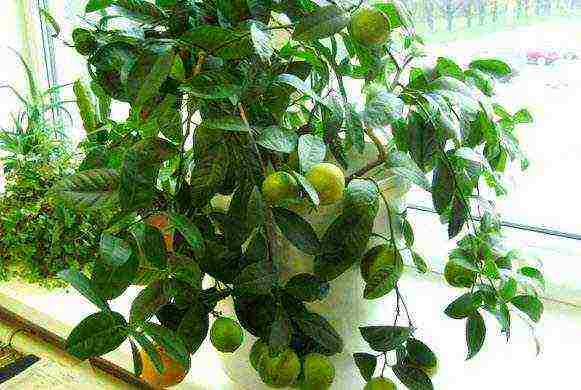
Lack of sunlight shouldn't kill the plant. When the days lengthen, the growth of the tree is activated, but at the same time fruiting is delayed. The southern and eastern windows are suitable for a houseplant. The most favorable place for lemon is the sills of the eastern windows, on which in the morning the sun's rays are bright, but not scorching. In hot summer, shield the flowerpot from the sun with a gauze curtain.
Indoor lemons do not like changes in light and rearrangement, the growth and development of fruits may slow down a little, but the tree will form correctly when turned.
Advice. In winter, it is advisable to arrange daylight illumination for 6 hours a day. Place an incandescent or fluorescent light bulb 60 cm above the tree.
Humidity
The most difficult period for indoor plants is October-March. The air in the apartment at this time is dry due to heating. Move the pot away or cover the batteries with a damp cloth. Spray the lemon periodically, but do not get carried away so as not to cause the development of the fungus. Place a cup of water in or near the pot.
In the summer, it is useful to have a cool shower once a week and wipe the leaves with a damp sponge. This is necessary so that the plant can breathe fully.
Important! The plant reacts painfully to changes in air humidity, dry air is especially dangerous at high temperatures during flowering and fruit formation. Flowers and ovaries may crumble. The more humid the air, the longer the leaves of the plant live.
Watering
In May and September, lemons should be watered daily, but in moderation. Swampy soil is categorically unsuitable, but overdried soil can also destroy the tree. Water the lemon less often during the winter, but keep it moist.
Important! Do not pour lemons with cold water or in the sun. The optimal watering time is morning or evening.
Temperature
The optimum temperature for the development of shoots and leaves is + 17 ° С, for the growth of fruits the temperature should be higher - + 21 ... 22 ° С. Lemons do not survive the heat well, especially in low humidity. In summer, when it gets warmer, flowers and ovaries can fall off, and temperature drops in autumn and winter can lead to falling leaves.
Attention! The soil temperature should be close to the air temperature. It is dangerous to bring lemon from the open air into a heated room. When it gets cold, try to gradually move the pot of the plant so that it can adapt to the new conditions.
Top dressing and fertilization
Fertilizers should be applied to the soil in moderation, but regularly, since their excess is harmful to plants.
By the state of the leaves, shoots and fruits, one can judge what kind of nutrition the lemon needs:
- The leaves turn yellow, the number of fruits decreases, and they become smaller - there is not enough nitrogen.
- The leaves turn pale and fall off, and the fruits are deformed and coarse - phosphorus deficiency.
- The leaves grow, and the fruits become smaller - potassium starvation.
- The tops of the branches dry out, the leaves turn pale and turn yellow, the lemon does not bloom and does not bear fruit - there is little iron.
It is recommended to fertilize lemons with 0.5% ammonium nitrate combined with potassium salt. With a lack of phosphorus, superphosphate is used.
In the summer, when the plant can be taken out of the house, you can feed it with organic fertilizer (bird droppings or water in which the meat was washed). It is not necessary to apply all fertilizers at the same time - lemons suffer from excessive feeding.
Carry out the planned feeding twice a month in the summer; from October to February, you do not need to feed the lemon.
Pruning
When growing indoor lemon, it is important not to let it grow to the size of a tree, especially since this plant is prone to forming long branches. If the bush is not cut, the crown will become too large. When pruning, part of the branches is removed after the fifth leaf - the crown from such a haircut will become productive and compact.
Lemon transplant
The fact that it is time to transplant the lemon is evidenced by the roots sticking out of the drainage hole, but this is a case of extreme neglect. A planned transplant should be carried out as the tree grows, each next flower pot should be slightly larger than the previous one. There are circumstances of a forced transplant, for example, a pot may break or you will feel an unpleasant odor from the soil.
If the lemon does not grow well, it can be transplanted in the fall, although the optimal time is the end of February, until active growth begins, or the middle of summer.
- Carefully take out the plant, cut off the broken and damaged roots, and sprinkle them with crushed coal or Kornevin. It is not necessary to completely shake off the earth lump.
- Place a drain on the bottom of the pot and add some river sand. Above - a layer of soil.
- Cut off some of the branches to make it easier for the roots to feed the plant.
- Make a depression in the soil, set the lump so that the neck is just below the edge of the pot. If you need to raise, fill up the earth.
- Sprinkle soil around the edges in layers, making sure that the trunk is in the middle of the pot.
- Trample the soil with your hands so that no voids remain.
- Pour with settled water and loosen the soil a little.
Advice. To make the lemon easier to bear stress, sprinkle it with Zircon and cover it with foil for 5-7 days.
Reproduction

Lemon propagation
Lemons can be cultivated by cuttings or seeds. A tree that has grown from a seed will bloom and begin to bear fruit no earlier than after 8 years. If you plant a cutting, you will wait for your own lemons in 4 years. A baby lemon that has grown from a seed does not necessarily inherit the characteristics of the variety from the parent tree, and identity is guaranteed when propagated by cuttings. But trees and seeds are more resistant to disease and better adapt to life in captivity.
Seed propagation
You can get the Lemon Seed from any ripe fruit. Each lemon contains several seeds, take them out and plant several pieces at a distance of 5 cm. It is better to plant seeds from several fruits.
Planting soil - well-drained peat and flower soil in a 1: 1 ratio. Deepen the seeds 1 cm and keep the soil moist without overflowing. At room temperature, the sprouts should appear in two weeks. Pick the tallest ones and delete the rest. Cover the sprout with a jar and place in a well-lit place without direct sunlight. Ventilate the sprout for several hours each day by removing the can.
When a few true leaves appear, plant the sprouts in pots up to 10 cm in diameter with good drainage. When replanting, try to keep the roots and soil around them. Pour a mixture of peat and soil for flowers into the pot. Transplant the plant that has grown up to 15-20 centimeters into an "adult" pot.
Propagation by cuttings
In the spring, semi-lignified twigs about 10 cm long with several leaves are cut off, and rooted in a homemade greenhouse with high humidity and temperature. Soil: peat and soil for flowers.
Lay drainage at the bottom of the pot, on top - a 5 cm layer of a mixture of turf and sand (6: 1), then - a mixture of sand and moss. This layer will mainly contain the root system of the future plant. Plant a cutting, water it and spray it with warm water. Cover with a can.
It is necessary to spray the cutting twice a day with water of about + 25 ° C until rooting occurs. At room temperature, the cutting should take root in 3-4 weeks. After that, remove the jar for several hours a day, and after a week, remove it completely. After another 7 days, you can transplant the cutting into a small pot with nutritious soil and reliable drainage. Within a year, you can transplant the lemon into a regular pot, and after 3-4 years it will begin to bloom.
Bloom
The tops of young shoots of lemon are pink-purple in color. The oval toothed leaves contain an essential oil. Leaves change after 2-3 years. Large lemon flowers (4-5 cm) bloom in the spring five weeks after the bud appears, flowering lasts more than two months. After the petals fall off, the fruit is tied, ripening in 200 or more days.
If a young plant begins to bloom in the first years of life, it is advisable to cut off the buds so that the tree can develop normally. When the buds appear a second time, they are no longer torn off - the lemon itself "decides" how many fruits it can feed. Extra buds will fly around by themselves. You can allow flowering when the tree already has at least 20 leaves. It is believed that each fruit needs at least 10 mature leaves.
Post-flowering care
Lemon grows, blooms and bears fruit all year round. One tree may contain ripe fruits, ovaries, flowers and buds. It is not necessary to pick off the faded inflorescences, as they turn into ovaries. If the lemon blooms in summer, the fruit ripens faster than in spring bloom.
Problems, diseases, pests
Many diseases of ornamental lemons are caused by improper care. With a lack of light and nutrients, lemon leaves brighten. Buds and leaves fly around if there is not enough moisture.The dryness of the indoor air is especially difficult for the plant, flowering may stop, the leaves darken and fall off.
Pests also often settle on the plant:
- Scabbards lead to the drying of branches, leaves and the death of the lemon. Remove the pests with a toothbrush and wash the lemon with soapy water.
- The spider mite settles on the wrong side of the leaves and the cobweb gradually envelops the entire tree. Spray with Actelika 0.15% solution three times, every 10 days.
- Mealybug leaves a sticky discharge on the leaves. Fruits and leaves fall off. It is recommended to inspect the plant and collect larvae.
- Citrus aphid. Actelika solution helps to get rid of this pest.
- Thrips and whiteflies also settle on lemons, which must be collected by hand, and the tree must be washed under the shower and treated with soapy water.
Popular types of indoor lemon
Meyer's lemon
Lemon Pavlovsky
Lemon Lunardio
Ponderosa lemon
Lemon Jubilee
- Meyer's lemon
- Lemon Pavlovsky
- Lemon Lunardio
- Ponderosa lemon
- Lemon Jubilee
Useful Tips
- If the lemon leaves turn brown, increase the indoor humidity and water the plant more often.
- Small leaves and thin shoots indicate that the lemon urgently needs to be fed and placed in a brighter place.
- Leaves dry and curl when there is not enough light and moisture. Spray a lemon every day, water and feed with complex fertilizers.
Answers on questions
The lifespan of indoor lemon
With careful attention and proper care, lemons live up to 45 years. An indoor flower dies ahead of time due to diseases and pests.
Why isn't the lemon blooming?
You have probably planted the plant in a pot that is too tight. Transplant it and feed it with complex fertilizer.
What if the lemon drops its leaves?
For lemon, leaf fall is a reaction to stress. Perhaps after the summer you moved it into the room or, conversely, sharply placed it under bright rays. Arrange artificial lighting or shadow. The reason may be excessive or insufficient watering - souring of the soil and drying out of the earthy coma are equally harmful for lemons. If the tree has not been watered for a long time, do not moisten the soil abundantly, add water little by little over several days.
Why does lemon shed fruit?
Lemon sheds fruits when it does not have enough strength to develop them. The first flowers that appear on a young lemon must be cut off, and only 2 fruits can be left on a three-year-old plant. In the future, each fruit should have at least 10 leaves.
How to arrange wintering?
The main task during the winter is to preserve the leaves. The room should not be too hot - no more than + 20оС. Keep the plant pot away from batteries and place a container of water next to it. If the windows are well protected from cold air, arrange a tree in the southeast or southwest window. Watering lemon in winter should not be as abundant as in the warm season.
Lemon grown in a pot on a windowsill will saturate the air in the house with phytoncides and essential oils, protecting against infectious diseases and bacteria. And in order for a miniature tree to regularly please not only in appearance, but also in fruits, it must be grafted. You can buy seedlings in specialized stores, but it is more interesting and cheaper to plant a seed in the ground and wait until it turns into a young sprout.

Choosing planting material
Where can I get a lemon seed? Go to the supermarket or the market, choose the largest fruit of a rich yellow hue and get a bone out of it. The main thing is that there are no spots and other damage on the citrus peel. In planting material taken from a dented or rotted sample, an infection or disease can lurk, which will destroy the fragile shoots that have hatched from the ground.
The purchased lemon is carefully cut, trying not to touch the shell of the seeds with the blade, and the seeds are removed.The planting material is immediately sorted: large specimens are left, small ones are thrown away, because they rarely sprout.
It is advisable to plant seeds in pots immediately, while they are still wet. But if there are several dry lemon grains left in the cabinet, which are a little more than a month or two, the workpiece is soaked in warm water for several hours, and then buried in the ground.
Lemons are also grown from cuttings, which can be got hold of friends or neighbors. Cut off a young twig from a fruiting tree, put it in water, add heteroauxin and wait a day. The cuttings must have at least 3 buds, and the mother lemon must necessarily produce at least 6–10 citruses per year.
how to grow a peach from a stone
Soil and pots
Some indoor trees grow up to 8–10 m in height, others stop at 3–4 m. Beginners, who are first engaged in lemons, try to plant a seed or cutting immediately in a huge pot or wooden box. The plant needs space, but when there is too much of it, the root system does not develop properly. Therefore, in the first step, a small clay pot or disposable plastic cup will suffice.

You can create a container for growing lemon from a bottle:
- Cut off half or a third. Discard the top with the lid, leaving the bottom of the bottle.
- Make many small holes in the bottom to ensure air circulation.
- Place the homemade pot on a plastic plate or tray so that excess water drains onto the stand instead of onto the windowsill.
- Fill a bottle with earth and plant a lemon seed in it.
You can also grow citrus seedlings in a flower pot, several pieces at once, but there should be a distance between them. It is recommended to mentally draw an equilateral triangle on the surface of the earth and stick 1-2 grains in each vertex of the geometric figure.
Used for growing lemons and wooden rectangular boxes. Between the seeds, 15–20 cm recede so that the root system has room for development. Regardless of the chosen container, a drainage layer 1–1.5 cm high is laid on the bottom of the pot or box. If it is absent, moisture begins to accumulate, the air circulates poorly and a fungus appears in the soil. The root system of the lemon rots and the plant disappears.
The following are used as drainage:
- small stones or pebbles;
- small pieces of pottery;
- grated foam;
- coarse sand;
- expanded clay or crushed wine cork.
Tip: To provide the plant with a nutrient medium, it is recommended to put a layer of peat, dried cow or horse manure, or a little moss on top of the drainage. The top dressing height is 1.5–2 cm, followed by the soil.
Perfect soil
Lemon is considered an unpretentious plant that can take root in any land. The main thing is to be warm and have enough moisture. Often seeds are planted in a mixture of sod soil, river sand and humus. More experienced gardeners add wood ash to the soil, which will feed weak sprouts.
Suitable for growing citrus trees and soil intended for indoor plants. You can buy soil in flower shops, it is advisable to add a little peat to the soil. If lemon cuttings are planted in pots, then a layer of sand is poured over the ground. This helps the citrus take root faster and take root in a new location.
how to grow tea at home
Disembarkation process
Make a small depression in the soil, about 1.5–2 cm, slightly moisten the soil and stick a few seeds into it. It is recommended to take 2-3 grains per hole, because some of the planting material may be empty and unviable. If several shoots hatch from the hole at once, the strongest and healthiest specimen is left, the rest are carefully pulled out or cut off to the very root.
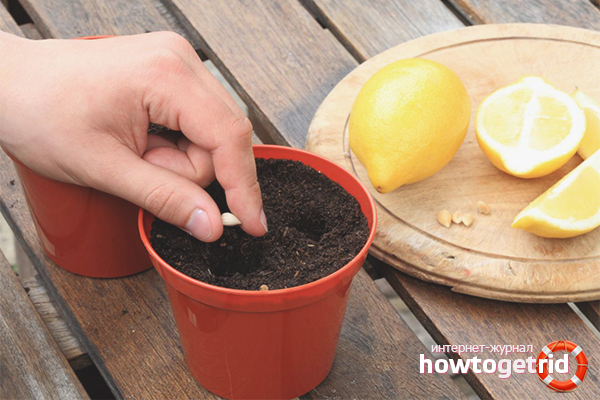
How everything happens:
- Put seeds in moistened soil, sprinkle them with earth and lightly tamp the soil.
- Spray the ground with warm distilled or melt water using a spray bottle.
- Cover the pot with a plastic bag to create a greenhouse effect.
- Place the lemons in a room where the temperature does not drop below +18. Before the first sprouts appear, the seeds do not need light, so citruses can be kept in any room.
- Periodically open the film and ventilate the soil in the pots, regularly moisten the soil with a spray bottle, but make sure that the soil is not too wet and damp.
They do it a little differently with cuttings:
- A twig, which has stood for several days in a special solution, is planted in the ground after the appearance of thin roots.
- The plant is buried so deep that only two buds remain on the surface, the rest must be hidden underground.
- At first, the stalk needs abundant watering, because the lemon does not have strong roots that can draw moisture from the soil.
- The plant feels comfortable at a temperature of + 18-20 degrees.
- It will take about 1.5-2 months for a citrus cut to take root in the pot and start growing actively.
Tip: If you overdo it with watering, and the earth cannot dry out in any way, you should not wait for mold to appear. The pot is freed of wet soil and filled with new dry soil, into which the lemon is transplanted.
how to grow pineapple at home
Citrus sprout care
Plant pots should be kept away from drafts, which citrus does not tolerate very well. The sprouts that have hatched are watered twice a week, and regularly exposed to the sun. When full-fledged leaves appear on the seedlings, the film is removed.
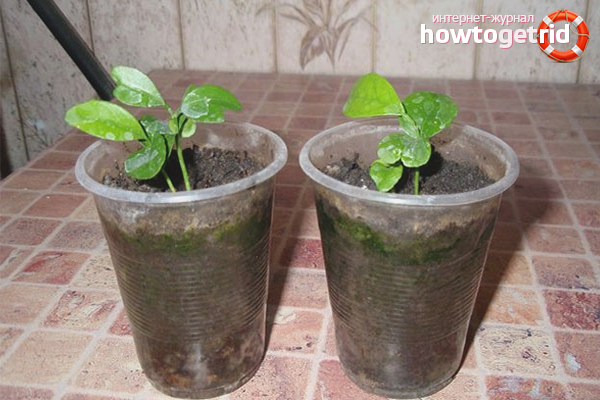
Little trick
You can cover the hatched lemon shoots not only with a bag, but also with an ordinary glass jar. Place the container upside down to create a greenhouse effect. Lemons stretch faster in humid conditions that resemble tropical climates. If citruses were planted in a pot in winter or early spring, the plant is placed next to a radiator or heater, and watered 3 times a week.
Water is used rain or thawed, warmed up to room temperature. The liquid for irrigation should settle for several days so that harmful impurities precipitate.
Fertilizer and transplant
Seedlings are fertilized every two weeks. Top dressing such as "Ideal" or "Zdraven" is suitable for citrus fruits. You can buy special fertilizers created for lemons and other exotic plants, but they must include:
- boron;
- manganese;
- zinc.
Citrus leaves are regularly wiped with a damp cloth to remove dust. The seedling pot should be on a well-lit window so that the plant receives a lot of ultraviolet radiation. But so that the sprouts stretch evenly and do not shed the leaves, the lemon should be turned around its axis by 1.5–2 cm every month. The seedlings should not be sharply twisted, otherwise such unexpected changes may result in the “baldness” of the young tree.
In early spring, the grown citrus is transferred to another, more spacious pot. In the first year, the lemon must "move" 4 times. An adult tree can live in its pot for several years, the main thing is to renew the topsoil from time to time.
How do you know if a lemon needs a new home? If its roots reach the drainage layer and try to crawl out of the pot, the tree becomes cramped. Move the lemon from one container to another carefully so as not to damage the base. A little soil is left on the root system so that the plant quickly adapts to new conditions.
Tree formation
So that the seedling does not turn into a shaggy bush of an incomprehensible shape, you need to take care of it. When the central shoot becomes strong and begins to stretch upward, acquiring twigs and additional leaves, it is cut off. A stump with a height of 20 cm should remain.Further, branches of the second order are formed on the central trunk, which are pinched when they reach 18-19 cm. Repeat the procedure again until the shoots of the fourth "generation" appear. It is on them that buds, flowers and fruits are formed.
If you do not cut off excess shoots and branches, the crown of the lemon will become thick, and the tree will spend too much energy on feeding the leaves and unnecessary shoots.
how to germinate oats properly
Growing fruiting citrus
When the stem of the seedling is as thick as a pencil, the lemon should be grafted. You need to ask friends or order in a specialized store a two-year-old cutting cut from a fruiting citrus. You will also need:
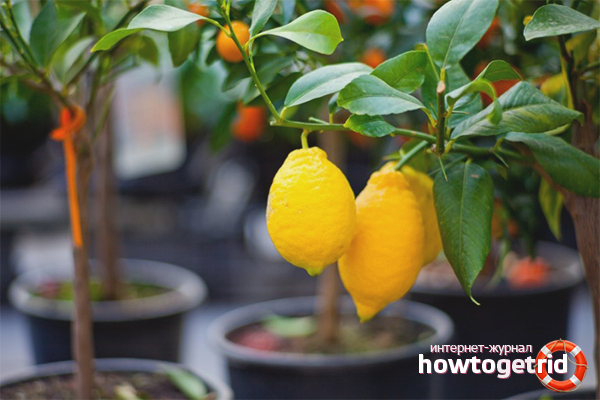
- well sharpened knife;
- a roll of electrical tape;
- plastic bag;
- garden var.
First, cut off the lemon branch extending from the central trunk, leaving a stump 5–10 cm high. It must be carefully split into two equal parts. Sharpen the bottom of the handle in the shape of a blade and insert into the stump. Coat the open "wounds" with garden pitch, pull tightly with electrical tape so that it covers the stump.
The top of the scion is also cut off, leaving 2 to 4 buds. Treat the cut with garden var, cover the pinned lemon with a bag to create a warm, humid microclimate. In such conditions, wounds heal faster, and the stalk takes root better. Remove the cellophane after the first shoots appear. The grafted lemon will begin to bear fruit in 2-3 years.
For the first time, 2 flowers are left, which must be pollinated with a cotton swab. Collect pollen from one dish and transfer to another. In the future, as many fruits can ripen on the lemon as the ovary appears.
how to organize watering while on vacation
Recommendations
- In late autumn, the temperature in the room where the citrus pot stands should be gradually reduced to 15 degrees so that the plant adapts to the harsh conditions. At the same time, daylight hours are increased, otherwise the tree will begin to shed its leaves.
- In winter, it is recommended to wrap the lemon tub with insulation or thick blankets to protect the roots from hypothermia.
- The soil is loosened every 5–6 irrigations to improve air flow into the soil and prevent soil acidification.
- In late spring and summer, it is useful to take a mature citrus tree outside, but hide it from direct sunlight.
Lemon, like other plants, needs regular care and attention. The plant loves warmth, moisture and sun in moderation, sometimes it needs feeding and protection from pests. If you do not forget to water the tree, apply fertilizer and keep it away from drafts, it will live a long time and regularly delight with fruits.
Video: how to grow citrus fruits at home


